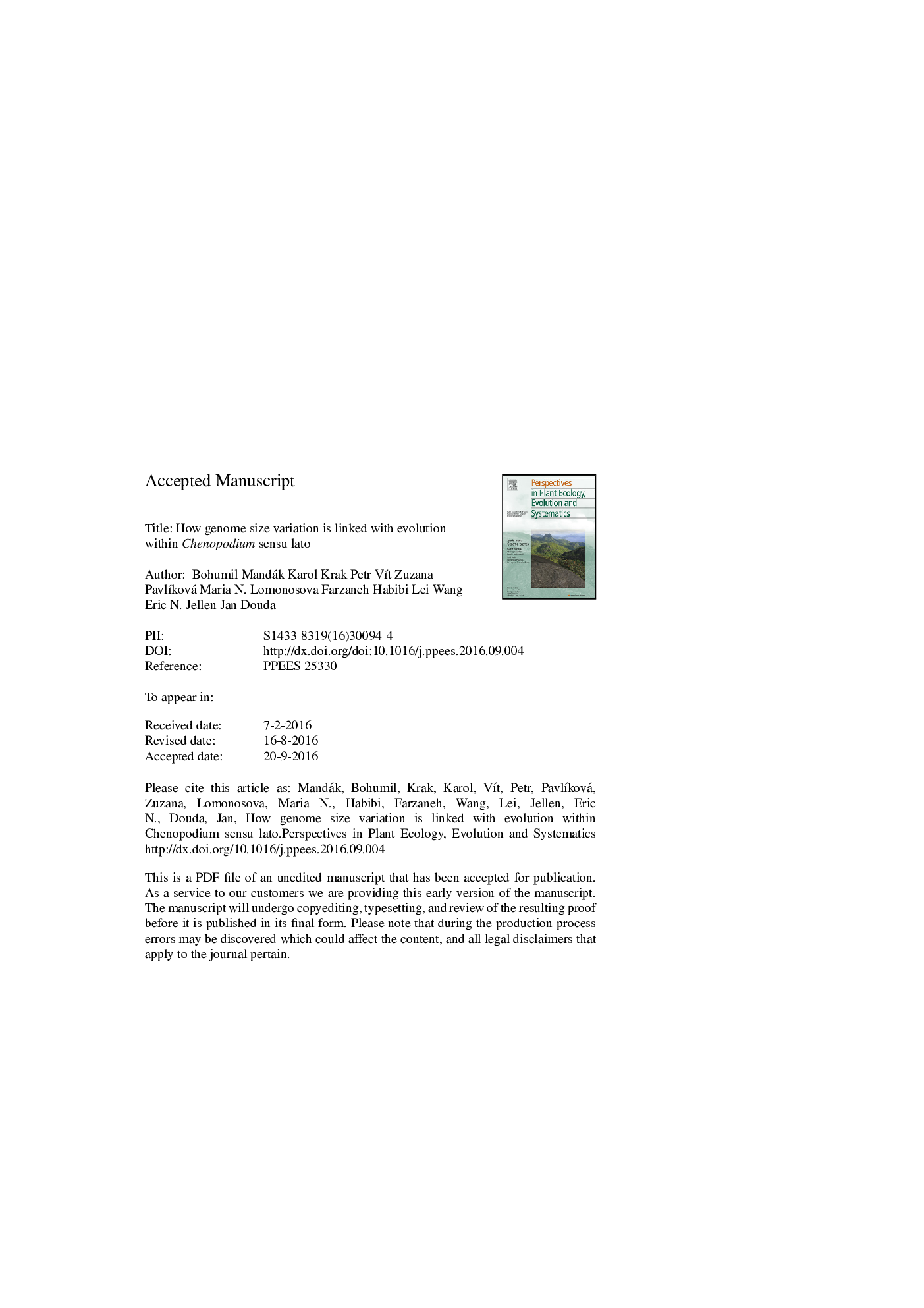| کد مقاله | کد نشریه | سال انتشار | مقاله انگلیسی | نسخه تمام متن |
|---|---|---|---|---|
| 6305705 | 1618597 | 2016 | 63 صفحه PDF | دانلود رایگان |
عنوان انگلیسی مقاله ISI
How genome size variation is linked with evolution within Chenopodium sensu lato
دانلود مقاله + سفارش ترجمه
دانلود مقاله ISI انگلیسی
رایگان برای ایرانیان
کلمات کلیدی
موضوعات مرتبط
علوم زیستی و بیوفناوری
علوم کشاورزی و بیولوژیک
بوم شناسی، تکامل، رفتار و سامانه شناسی
پیش نمایش صفحه اول مقاله

چکیده انگلیسی
The significance of the wide interspecific variation in nuclear genome size of angiosperms is still not fully understood. It has been repeatedly suggested, however, that genome size can impose phenotypic constraints on plant development, phenology and ecological performance. We analysed nuclear genome size variation in diploid and polyploid species of Chenopodium s. lat. within a phylogenetic framework using flow cytometry of 456 accessions from 175 populations of 49 species: 32 diploids, 12 tetraploids, 4 hexaploids, and one decaploid. To this end, we also determined chromosome numbers and did an ITS-based phylogenetic reconstruction to analyze genome size variation using the phylogenetic generalized least-squares approach (PGLS). Results of these experiments can be summarized as follows. (1) We report the first chromosome counts for five Chenopodium species. (2) Flow cytometry determined that 2C and 1Cx DNA values differed up to 7.83- and 3.60-fold, respectively, with the lowest 1Cx value for C. schraderianum (0.412 pg) [excluding tetraploid (2n = 4 x = 32) C. ambrosioides with x = 8 and 1Cx DNA content 0.279 pg] and the highest for C. californicum (1.484 pg). (3) Our extended phylogeny confirms the existence of previously recognized basic evolutionary lineages while underscoring the need to further increase taxon sampling for a full understanding of relationships in Chenopodioideae. (4) Our analysis of genome size evolution estimated the ancestral genome size of Chenopodium s. lat. at 0.541 pg/1Cx. In addition, the data revealed a correlation between 1Cx DNA content and ploidy level. Moreover, the PGLS approach indicated that the genome size variation (i) followed the random walk model, indicating no unambiguous trend towards genome size increase or decrease; (ii) was correlated with phylogeny (λ = 0.987); (iii) evolved gradually (κ = 2.256); and (vi) occurred rather late after speciation, which can be attributed to species-specific adaptation (δ = 3.000). (5) There are indications that several ecological traits were significantly associated with 2C DNA content. While mean plant height, maximum plant height, fruit diameter and life form were positively correlated with genome size, the species' continent of origin showed no correlation. In summary, the strong phylogenetic signal detected in genome size of Chenopodium indicates that its genome size variation is significantly associated with phylogenetic divergence. We herein suggest a pattern of species-specific adaptations in the evolution of Chenopodium genome size.
ناشر
Database: Elsevier - ScienceDirect (ساینس دایرکت)
Journal: Perspectives in Plant Ecology, Evolution and Systematics - Volume 23, December 2016, Pages 18-32
Journal: Perspectives in Plant Ecology, Evolution and Systematics - Volume 23, December 2016, Pages 18-32
نویسندگان
Bohumil Mandák, Karol Krak, Petr VÃt, Zuzana PavlÃková, Maria N. Lomonosova, Farzaneh Habibi, Lei Wang, Eric N. Jellen, Jan Douda,